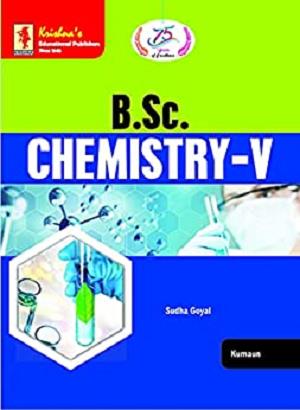
Krishna's - B.Sc Chemistry V, Edition-2 PDF
388 Pages·2021·6.8827 MB·other
Most books are stored in the elastic cloud where traffic is expensive. For this reason, we have a limit on daily download.
Preview Krishna's - B.Sc Chemistry V, Edition-2
Description:
SYLLABUS- B.Sc. CHEMISTRY-V,
INORGANIC CHEMISTRY-V
B.Sc. Vth Semester; Ist Paper
1.Thermodynamic and Kinetic Aspects of Coordination Compounds: A brief outline of thermodynamic and kinetic stability of metal complexes and factors affecting the stability of coordination compounds. Substitution reactions in square planar complexes. 6 Lectures
2.Metal-Ligand Bonding in transition Metal Complexes: Limitations of valence bond theory, an elementary idea about crystal field theory; crystal field splitting octahedral, tetrahedral and square planar complexes, factors affecting the crystal-field parameters. 6 Lectures
3.Magnetic Properties of Transition Metal Complexes: Types of magnetic behaviour, methods of determining magnetic susceptibility; Gouy's and Quincke's methods, spin only formula, correlation of µs and µeff values, orbital contribution to magnetic moments, application of magnetic moment data for 3d metal complexes. 6 Lectures
4.Electronic Spectra of Transition Metal Complexes: Types of electronic transitions, selection rules for d-d
transitions, spectroscopic ground states, spectrochemical series. Orgel energy level diagram for d1, d4 and d6,
d9 states, discussion of the electronic spectrum of [Ti(H2O)6] 3+ complex ion. 6 Lectures
5.Electro-analytical Techniques: Basic concepts of electrogravimetric and coulometric analysis. Thermogravimetric analysis. Voltametry; principle of polarography. 6 Lectures
ORGANIC CHEMISTRY-V
B.Sc. Vth Semester; IInd Paper
1.Spectroscopy: Nuclear magnetic resonance (NMR) spectroscopy; Proton magnetic resonance (1H NMR) spectroscopy, nuclear shielding and deshielding, chemical shift and molecular structure, spin-spin splitting and coupling constants, areas of signals, interpretation of pmr spectra of simple organic molecules such as ethyl bromide, ethanol, acetaldehyde, 1,1,2-tribromoethane, ethyl acetate, toluene and acetophenone, Problems pertaining to the structure elucidation of simple organic isoquinolene.compounds using UV, IR and PMR spectroscopic techniques 6 Lectures
2.Organo-Metallic Compounds: Organomagnesium compounds; the Grignard reagent-formation, structure and chemical reactions. Organozinc compounds; formation and chemical reactions. 5 Lectures
3.Organo-Sulphur Compounds: Nomenclature, structural features, methods of formation and chemical reactions of thiols, thioethers, sulphonic acid, sulphonamides and sulphaguanidine. 5 Lectures
4.Hetrocyclic Compounds: Introduction: Molecular orbital picture and aromatic characteristics of pyrrole, furan, thiophene and pyridine. Methods of synthesis and chemical reactions with particular emphasis on the mechanism of electrophilic substitution. Mechanism of nucleophilic substitution reactions in pyridine derivatives. Comparison of basicity of pyridine, piperidine and pyrrole. Introduction of condensed five- and six membered heterocycles. Preparation and reactions of quinolene and isoquinolene with special reference to Fischer-Indole synthesis, Skraups synthesis and Bischler-Napieralski synthesis. Mechanism of electrophilic substitution reactions of quinolene and isoquinolene. 8 Lectures
5.Carbohydrates:
INORGANIC CHEMISTRY-V
B.Sc. Vth Semester; Ist Paper
1.Thermodynamic and Kinetic Aspects of Coordination Compounds: A brief outline of thermodynamic and kinetic stability of metal complexes and factors affecting the stability of coordination compounds. Substitution reactions in square planar complexes. 6 Lectures
2.Metal-Ligand Bonding in transition Metal Complexes: Limitations of valence bond theory, an elementary idea about crystal field theory; crystal field splitting octahedral, tetrahedral and square planar complexes, factors affecting the crystal-field parameters. 6 Lectures
3.Magnetic Properties of Transition Metal Complexes: Types of magnetic behaviour, methods of determining magnetic susceptibility; Gouy's and Quincke's methods, spin only formula, correlation of µs and µeff values, orbital contribution to magnetic moments, application of magnetic moment data for 3d metal complexes. 6 Lectures
4.Electronic Spectra of Transition Metal Complexes: Types of electronic transitions, selection rules for d-d
transitions, spectroscopic ground states, spectrochemical series. Orgel energy level diagram for d1, d4 and d6,
d9 states, discussion of the electronic spectrum of [Ti(H2O)6] 3+ complex ion. 6 Lectures
5.Electro-analytical Techniques: Basic concepts of electrogravimetric and coulometric analysis. Thermogravimetric analysis. Voltametry; principle of polarography. 6 Lectures
ORGANIC CHEMISTRY-V
B.Sc. Vth Semester; IInd Paper
1.Spectroscopy: Nuclear magnetic resonance (NMR) spectroscopy; Proton magnetic resonance (1H NMR) spectroscopy, nuclear shielding and deshielding, chemical shift and molecular structure, spin-spin splitting and coupling constants, areas of signals, interpretation of pmr spectra of simple organic molecules such as ethyl bromide, ethanol, acetaldehyde, 1,1,2-tribromoethane, ethyl acetate, toluene and acetophenone, Problems pertaining to the structure elucidation of simple organic isoquinolene.compounds using UV, IR and PMR spectroscopic techniques 6 Lectures
2.Organo-Metallic Compounds: Organomagnesium compounds; the Grignard reagent-formation, structure and chemical reactions. Organozinc compounds; formation and chemical reactions. 5 Lectures
3.Organo-Sulphur Compounds: Nomenclature, structural features, methods of formation and chemical reactions of thiols, thioethers, sulphonic acid, sulphonamides and sulphaguanidine. 5 Lectures
4.Hetrocyclic Compounds: Introduction: Molecular orbital picture and aromatic characteristics of pyrrole, furan, thiophene and pyridine. Methods of synthesis and chemical reactions with particular emphasis on the mechanism of electrophilic substitution. Mechanism of nucleophilic substitution reactions in pyridine derivatives. Comparison of basicity of pyridine, piperidine and pyrrole. Introduction of condensed five- and six membered heterocycles. Preparation and reactions of quinolene and isoquinolene with special reference to Fischer-Indole synthesis, Skraups synthesis and Bischler-Napieralski synthesis. Mechanism of electrophilic substitution reactions of quinolene and isoquinolene. 8 Lectures
5.Carbohydrates:
See more
The list of books you might like
Most books are stored in the elastic cloud where traffic is expensive. For this reason, we have a limit on daily download.
